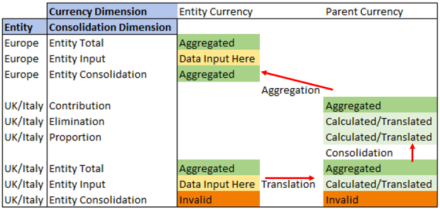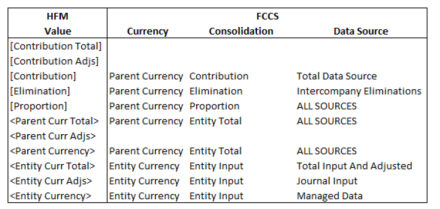Talking Tech: Understanding Consolidations in Oracle’s FCCS
Let’s Talk Tech.
Accordion’s “Talking Tech” series explores how different CFO Technology solutions can empower finance functions to support organizational strategic initiatives – by implementing business process recommendations, optimizing operations, and capitalizing on value creation opportunities.
Now, let’s take a look at the consolidation process in Oracle.
Let’s say that you have been using Oracle’s HFM for a while to do consolidations and finally have a good understanding of how the consolidation process works using the Value dimension. Now your company decides it’s time to go to the cloud and purchases Oracle Financial Consolidation and Close Cloud (FCCS). Well guess what? Oracle has gone and changed the consolidation process. But do not fear, this post will refresh your knowledge of consolidations in HFM and guide you through the same in FCCS.
In order to examine the process, we are going to contrast applications set up in both FCCS and HFM. In our applications, we have data loaded into two base entities, UK and Italy. Both roll up into a parent level entity, Europe. The table below indicates the Entity Currency setting for each of the entities, as well as their Parent Currency. The Parent Currency helps understand what currency that entity’s data will naturally translate into during a consolidation.
HFM CONSOLIDATIONS REVIEW

First, let’s review how data translates and consolidates in an HFM application, with the primary driver being the Value dimension. Below is a retrieval from our HFM application. Here we can see that data was loaded to the UK and Italy entities at the Entity Currency Value member. After a consolidation was run, Europe populated with the translated and consolidated results of UK and Italy.

How does that happen? After data is loaded to Entity Currency, adjustments can be made via HFM’s journal entry module to Entity Curr Adjs. The sum of Entity Currency and Entity Curr Adjs gives us our Entity Curr Total Amount {Column C + Column D = Column E}.
Upon consolidation, HFM will translate our Entity Curr Total to our entity’s immediate parent’s currency. So, in the example of our UK entity, their Entity Curr Total of GBP will be translated into EUR, as that is the Entity Currency for Europe. This new translated amount in Parent Currency can have adjustments applied to it in the translated currency via the journal entry module. Parent Curr Total is the sum of Parent Currency and these adjustments, which are booked to Parent Curr Adjs {Column F (post translated UK results) + Column G (EUR Journal booked on the UK) = Column H (Parent Curr Total)}
The next step in the HFM consolidation process is to determine the Proportion value. Proportion is calculated by applying an ownership percent to the entity’s Parent Curr Total. In our example UK and Italy are 100% owned by Europe, so the entire Parent Curr Total comes through to the Proportion member. After we have our Proportion, HFM will calculate if there are any Eliminations. Eliminations occur when two entities in a company do business with each other. The activity is captured at a base level entity, but will need to net out at the first common parent. The amount attributed to intercompany activity is calculated in the Elimination value member.
Finally, HFM is at the point of calculating what will be passed on from UK and Italy to Europe. The Contribution member is the sum of Proportion and Elimination and is the amount that will be passed to Europe at the Entity Currency value member. This process continues and repeats itself up the entity hierarchy until you get to the top-most node of the entity hierarchy.
THE BRAVE NEW WORLD OF FCCS
Now that we have reviewed how data flows through the Value dimension in HFM, let’s look at how data translates and consolidates in FCCS. While similar to HFM, FCCS breaks this process out into two dimensions: Currency and Consolidation. Below is a screen shot from our FCCS application showing how that same data is flowing from UK and Italy into Europe.

At first glance, this SmartView pull looks almost identical to the pull from HFM, how different could the process be? Well, let’s see.
Here we have a workflow drawn up that can walk us through the FCCS Consolidation Process.

As you can see, the dimensions that take center stage of the consolidation process are Currency and Consolidation, while our entity members will remain the same. Again, at first glance you might think that nothing has changed, since Currency and Consolidation resemble certain parts of the Value dimension. The key difference here is understanding the specific combinations of Currency and Consolidation that are used to take data from a base entity in its local currency, to a translated and consolidated parent entity.
In FCCS, data is loaded to the intersection of Entity Currency (Currency) and Entity Input (Consolidation). Looking at the graphic, you might think that Entity Consolidation is the starting point. But at a base entity, Entity Consolidation is an invalid intersection – no data can be loaded to this intersection. Entity Consolidation is only valid at a parent entity and is where the consolidated total of the parent entity’s children is populated.
Going back to our base entity, the data at Entity Input/Entity Currency is then translated, with the results being populated in the intersection of Parent Currency and Entity Input. The data then moves to Entity Total, at Parent Currency. This is where Entity Input and Entity Consolidation add up. From here, the process begins to resemble the HFM consolidation process. The Entity Total/Parent Currency intersection is then used to calculate the Proportion and Elimination amounts, just like they would in HFM. The sum of Proportion and Elimination will give you your Contribution, which is then written to the Entity Consolidation/Entity Currency for the parent entity.

The chart above provides a direct comparison of how the Value dimension in HFM lines up to the Currency and Consolidation dimensions in FCCS. As a bonus, it also depicts the Data Source dimension, which is a system dimension used to track different types of input and calculations. Data Source gives users even more ability to trace where data in the system came from and understand the consolidation process. It allows you to easily distinguish between loaded data, journal inputs, and even intercompany eliminations, which can be automatically written against a dedicated Data Source member.
As you can see, the two systems follow a similar logic of translating data from base entities and consolidating it up to a parent level. FCCS has essentially broken up the HFM Value dimension into two dimensions – Currency and Consolidation – to achieve the same outcome. Hopefully, after reading this blog post, you will feel less overwhelmed by Oracle changing the process you came to know and love and are more prepared for the big move to the cloud!
PS – Don’t think we forgot about Journal Entries in FCCS. Stay tuned for a future blog centered around the Journal Entry Module in FCCS! In the meantime, please feel free to contact us with any questions or other inquiries about your consolidations process.

